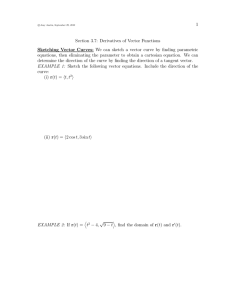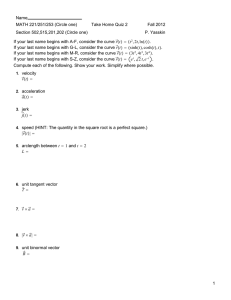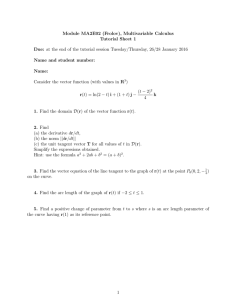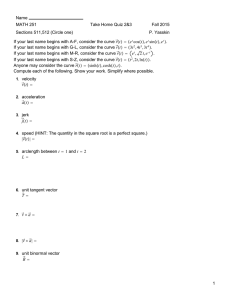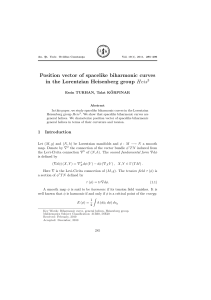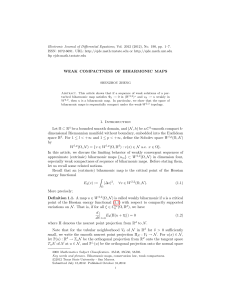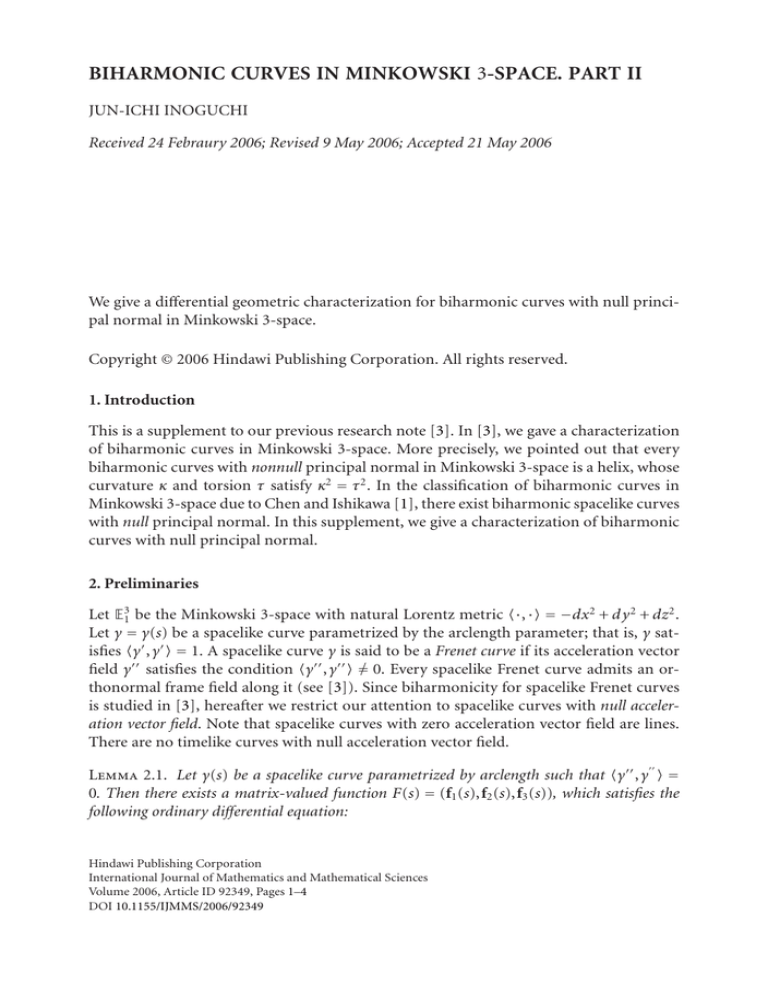
BIHARMONIC CURVES IN MINKOWSKI 3-SPACE. PART II
JUN-ICHI INOGUCHI
Received 24 Febraury 2006; Revised 9 May 2006; Accepted 21 May 2006
We give a differential geometric characterization for biharmonic curves with null principal normal in Minkowski 3-space.
Copyright © 2006 Hindawi Publishing Corporation. All rights reserved.
1. Introduction
This is a supplement to our previous research note [3]. In [3], we gave a characterization
of biharmonic curves in Minkowski 3-space. More precisely, we pointed out that every
biharmonic curves with nonnull principal normal in Minkowski 3-space is a helix, whose
curvature κ and torsion τ satisfy κ2 = τ 2 . In the classification of biharmonic curves in
Minkowski 3-space due to Chen and Ishikawa [1], there exist biharmonic spacelike curves
with null principal normal. In this supplement, we give a characterization of biharmonic
curves with null principal normal.
2. Preliminaries
Let E31 be the Minkowski 3-space with natural Lorentz metric ·, · = −dx2 + d y 2 + dz2 .
Let γ = γ(s) be a spacelike curve parametrized by the arclength parameter; that is, γ satisfies γ ,γ = 1. A spacelike curve γ is said to be a Frenet curve if its acceleration vector
field γ satisfies the condition γ ,γ = 0. Every spacelike Frenet curve admits an orthonormal frame field along it (see [3]). Since biharmonicity for spacelike Frenet curves
is studied in [3], hereafter we restrict our attention to spacelike curves with null acceleration vector field. Note that spacelike curves with zero acceleration vector field are lines.
There are no timelike curves with null acceleration vector field.
Lemma 2.1. Let γ(s) be a spacelike curve parametrized by arclength such that γ ,γ =
0. Then there exists a matrix-valued function F(s) = (f1 (s),f2 (s),f3 (s)), which satisfies the
following ordinary differential equation:
Hindawi Publishing Corporation
International Journal of Mathematics and Mathematical Sciences
Volume 2006, Article ID 92349, Pages 1–4
DOI 10.1155/IJMMS/2006/92349
2
Biharmonic curves in Minkowski 3-space. Part II
⎛
⎞
0 0 −1
⎜
0⎟
∇γ F = F ⎝1 k
⎠,
0 0 −k
f1 = γ .
(2.1)
Here ∇ is the Levi-Civita connection of E31 .
Conversely, let F(s) = (f1 (s),f2 (s),f3 (s)) be a solution to (2.1). Then there exists a spacelike curve γ(s) with arclength parameter s such that
γ = f1 ,
γ ,γ = 0.
(2.2)
Proof. By the assumption, f 1 = γ is a null vector field. We set f2 = f1 . Since f1 = γ is a
unit spacelike vector field, there exists a unique null vector field f3 along γ such that (cf.
[2])
f2 ,f3 = 1,
f1 ,f3 = 0.
(2.3)
One can check that F = (f1 ,f2 ,f3 ) satisfies (2.1). For instance, expand f2 as f2 = af1 + bf2 +
cf3 . Then
a = f2 ,f1 = − f2 ,f1 = 0,
c = f2 ,f2 = f2 ,f2
= 0.
(2.4)
Hence f2 = bf2 . By similar computations, we get
f3 = −f1 − bf3 .
(2.5)
Thus F satisfies (2.1) with k = b.
Conversely, let F be a solution to (2.1). Then F satisfies the following conditions (cf.
[2, Section 2]):
f1 ,f1 = 1,
f2 ,f3 = 1,
f2 ,f2 = f3 ,f3 = 0,
f1 ,f2 = f1 ,f3 = 0.
(2.6)
Integrating f1 (s) by s, we obtain a spacelike curve γ(s) with null acceleration, since γ =
f1 = f2 .
We call the matrix-valued function F, the null frame of γ. We call f1 , f2 , and f3 , the
tangent vector field, principal normal vector field, and binormal vector field of γ, respectively.
We call the function k the curvature function of γ. Note that both principal normal and
binormal are null.
Example 2.2. Let us consider γ with k = 0. Since f2 = 0, we have
f1 = sn + u,
(2.7)
where the constant vectors n and u satisfy the relation
n,n = n,u = 0,
u,u = 1.
(2.8)
Jun-Ichi Inoguchi 3
Thus we obtain
γ(s) =
s2
n + su + v,
2
(2.9)
where v is a constant vector. Hence γ is congruent to
bs2 ,bs2 ,s ,
b = 0.
(2.10)
Next, assume that k is a nonzero constant, then γ is given by
γ(s) =
1 ks
e n + su + v.
k2
(2.11)
Here the constant vectors n and u satisfy (2.8). Hence γ is congruent to
a ks a ks
e , 2 e ,s ,
k2
k
a = 0.
(2.12)
Example 2.3. Let us determine spacelike curves with 1/k = s + c, where c is a constant.
Then γ is given by
s3 cs2
n + su + v,
+
γ(s) =
3
2
(2.13)
where the constant vectors n and u satisfy (2.8). Thus γ is congruent to the curve
as3 + bs2 ,as3 + bs2 ,s ,
a = 0.
(2.14)
3. Biharmonic curves
We start this section with recalling the notion of biharmonicity.
Let γ be a spacelike curve in E31 parametrized by arclength defined on an open interval
I. We denote by γ∗ T E31 the vector bundle over I obtained by pulling back the tangent
bundle T E31 :
γ∗ T E31 =
Tγ(s) E31 .
(3.1)
s ∈I
The Laplace operator Δ acting on the space Γ(γ∗ T E31 ) of all smooth vector fields along γ
is given by
Δ = −∇γ ∇γ .
(3.2)
A spacelike curve γ is said to be biharmonic if ΔH = 0, where H is the mean curvature
vector field of γ.
Chen and Ishikawa obtained the following result.
Theorem 3.1 [1]. Let γ(s) be a spacelike curve parametrized by arclength with null acceleration vector field. Then γ is biharmonic if and only if γ is congruent to
as3 + bs2 ,as3 + bs2 ,s ,
a2 + b2 = 0.
(3.3)
4
Biharmonic curves in Minkowski 3-space. Part II
Now we give a geometric characterization of biharmonic spacelike curve with null
principal normal. Let γ(s) be a spacelike curve parametrized by arclength with null acceleration vector field. Then the mean curvature vector field H is given by
H = ∇ γ γ = f2 .
(3.4)
ΔH = −(k + k2 )f2 .
(3.5)
Thus we obtain
Hence γ is biharmonic if and only if k + k2 = 0. Hence the curvature function k is given
by k = 0 or 1/k(s) = s + c, where c is a constant.
Proposition 3.2. A spacelike curve γ(s) parametrized by arclength parameter s with null
principal normal vector field is biharmonic if and only if its curvature function is given by
k = 0 or 1/k = s + c for some constant c. Hence such curves are congruent to the curve (3.3).
The former case (k = 0) corresponds to the case a = 0 (2.10) and the latter case (1/k = s + c)
to a = 0 (2.14), respectively.
References
[1] B.-Y. Chen and S. Ishikawa, Biharmonic surfaces in pseudo-Euclidean spaces, Memoirs of the Faculty of Science. Kyushu University. Series A. Mathematics 45 (1991), no. 2, 323–347.
[2] L. K. Graves, Codimension one isometric immersions between Lorentz spaces, Transactions of the
American Mathematical Society 252 (1979), 367–392.
[3] J. Inoguchi, Biharmonic curves in Minkowski 3-space, International Journal of Mathematics and
Mathematical Sciences 2003 (2003), no. 21, 1365–1368.
Jun-Ichi Inoguchi: Department of Mathematics Education, Faculty of Education,
Utsunomiya University, Utsunomiya, 321-8505, Japan
E-mail address: inoguchi@cc.ustunomiya-u.ac.jp


